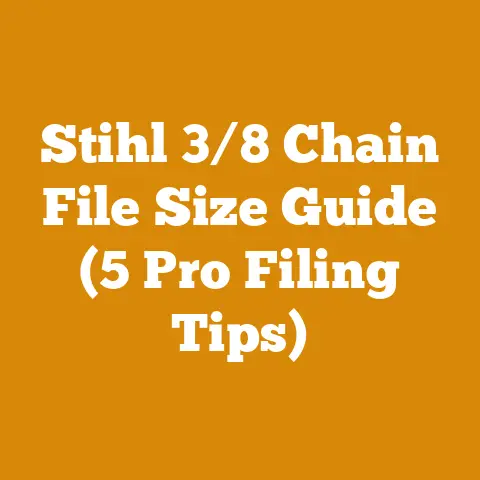How to Clean a Stihl Chainsaw Carburetor (Fix Smoking & Boost Power)
Ever noticed your Stihl chainsaw puffing out more smoke than usual, or lacking the punch it used to have when tackling those thick logs? Chances are, the culprit is a dirty carburetor. Think of it as the chainsaw’s lungs – if it’s clogged, the whole engine suffers. I’ve spent years felling trees, processing timber, and prepping firewood, and I can tell you, a properly maintained carburetor is the key to a happy, powerful chainsaw. In this guide, I’ll walk you through how to clean a Stihl chainsaw carburetor, step-by-step, to fix those smoking issues and get your saw roaring back to life.
Understanding the Importance of a Clean Carburetor
Before diving into the nitty-gritty, let’s understand why a clean carburetor is so crucial. The carburetor’s job is to mix the right amount of fuel with air to create a combustible mixture that powers the engine. Over time, tiny passages within the carburetor can become clogged with dirt, debris, old fuel residue, and oil deposits. This leads to:
- Reduced Power: The engine doesn’t get enough fuel, resulting in sluggish performance and difficulty cutting through wood.
- Excessive Smoke: An improper air-fuel mixture causes incomplete combustion, leading to more smoke.
- Difficult Starting: A clogged carburetor can make starting the chainsaw a real struggle.
- Engine Stalling: The engine might stall frequently, especially at idle.
- Increased Fuel Consumption: The engine has to work harder, burning more fuel.
Ignoring these symptoms can eventually lead to more serious engine damage. Regular carburetor cleaning is a simple, preventative measure that can save you time, money, and frustration in the long run.
Essential Tools and Materials
Before you start, gather the following tools and materials:
- Stihl Chainsaw Wrench/Scrench: This multi-tool usually comes with your chainsaw and is essential for removing parts.
- Screwdrivers: A set of small, flathead and Phillips head screwdrivers. Precision screwdrivers are particularly helpful for adjusting carburetor settings.
- Carburetor Cleaner: A specialized spray cleaner designed to dissolve fuel residue and varnish. I recommend a brand specifically formulated for small engines.
- Compressed Air: A can of compressed air or an air compressor with a nozzle to blow out debris from the carburetor passages.
- Clean Rags or Shop Towels: For wiping up spills and cleaning parts. Lint-free rags are ideal.
- Small Containers: To hold small parts during disassembly. Egg cartons or small plastic containers work well.
- Carburetor Rebuild Kit (Optional): If your carburetor is severely clogged or has damaged gaskets, a rebuild kit is a good investment.
- Protective Gloves: To protect your hands from fuel and chemicals.
- Safety Glasses: To protect your eyes from flying debris and cleaner spray.
- Camera or Smartphone: To take pictures during disassembly. This will help you remember how everything goes back together.
- Work Bench or Table: A clean, well-lit workspace is essential.
Personal Experience: I once tried cleaning a carburetor without safety glasses. A small burst of carburetor cleaner sprayed into my eye. Trust me, it’s not a pleasant experience. Wear safety glasses!
Step-by-Step Guide to Cleaning Your Stihl Chainsaw Carburetor
Now, let’s get down to the cleaning process. This guide applies broadly to most Stihl chainsaw models, but there might be slight variations. Always refer to your chainsaw’s owner’s manual for specific instructions.
Step 1: Safety First!
- Turn off the chainsaw: Ensure the chainsaw is completely turned off.
- Disconnect the spark plug: Remove the spark plug wire to prevent accidental starting. This is a crucial safety precaution.
- Allow the engine to cool: Never work on a hot engine. Let it cool down completely.
- Work in a well-ventilated area: Carburetor cleaner fumes can be harmful. Work outdoors or in a well-ventilated garage.
Step 2: Accessing the Carburetor
- Remove the Air Filter Cover: Use the Stihl wrench or a screwdriver to remove the air filter cover. This is usually held in place by screws or clips.
- Remove the Air Filter: Carefully remove the air filter. Inspect it for dirt and damage. If it’s dirty, clean it with warm, soapy water and let it dry completely before reinstalling. A clogged air filter can also contribute to engine problems.
- Remove the Carburetor Cover/Housing: Depending on your model, you may need to remove a plastic cover or housing to access the carburetor. This is typically held in place by screws. Take note of how the throttle linkage and choke linkage are connected.
- Photograph the Linkages: Before disconnecting any linkages, take clear pictures of how the throttle and choke linkages are connected to the carburetor. This will save you a lot of headache during reassembly.
Step 3: Disconnecting the Carburetor
- Disconnect Fuel Lines: Carefully disconnect the fuel lines from the carburetor. Use pliers if necessary, but be gentle to avoid damaging the lines. Fuel lines can become brittle over time, so handle them with care. Have a rag handy to catch any spilled fuel.
- Disconnect Throttle and Choke Linkages: Disconnect the throttle and choke linkages from the carburetor. Refer to the pictures you took earlier to ensure you understand how they are connected.
- Remove the Carburetor Mounting Bolts: Remove the bolts or screws that hold the carburetor to the engine.
- Carefully Remove the Carburetor: Gently pull the carburetor away from the engine.
Step 4: Carburetor Disassembly
Important Note: Carburetors contain very small parts that can be easily lost. Work on a clean surface and use small containers to keep track of everything.
- Remove the Fuel Bowl (if applicable): Some carburetors have a fuel bowl at the bottom. Carefully remove it by unscrewing the retaining screw. Be prepared for some fuel to spill.
- Remove the Needle Valve: The needle valve is usually located inside the fuel bowl or near the fuel inlet. Carefully remove it.
- Remove the Jets: Carburetors typically have two or three jets: a high-speed jet, a low-speed jet, and sometimes an idle jet. Use a small screwdriver to carefully remove these jets. Note their positions, as they may be different sizes.
- Remove the Welch Plug (if necessary): Some carburetors have a Welch plug covering a passage. I generally advise against removing this unless it’s absolutely necessary, as it can be difficult to reinstall properly. If you must remove it, use a small pick or awl to carefully pry it out.
- Remove Other Components: Depending on your carburetor model, there may be other small components, such as diaphragms, gaskets, and O-rings. Carefully remove these, noting their positions. If you’re using a carburetor rebuild kit, now is the time to compare the old parts to the new ones.
Step 5: Cleaning the Carburetor
- Spray with Carburetor Cleaner: Thoroughly spray all the carburetor components with carburetor cleaner. Pay particular attention to the jets and any small passages.
- Soak the Parts (Optional): For heavily clogged carburetors, you can soak the parts in carburetor cleaner for a few hours or overnight.
- Clean the Jets: Use a small wire or a carburetor cleaning tool to carefully clean the jets. Make sure the passages are clear. You can also use compressed air to blow out the jets.
- Clean the Carburetor Body: Spray the carburetor body with carburetor cleaner and use a brush or rag to remove any dirt or residue.
- Blow Out Passages with Compressed Air: Use compressed air to blow out all the passages in the carburetor body. This is crucial to remove any remaining debris.
- Inspect the Parts: Carefully inspect all the parts for damage or wear. Replace any parts that are damaged.
Step 6: Carburetor Reassembly
- Install New Gaskets and O-rings: If you’re using a carburetor rebuild kit, install the new gaskets and O-rings. This is important to ensure a good seal.
- Reinstall the Jets: Carefully reinstall the jets in their original positions. Make sure they are snug but not overtightened.
- Reinstall the Needle Valve: Reinstall the needle valve.
- Reinstall the Welch Plug (if removed): If you removed the Welch plug, carefully reinstall it. You may need a special tool to crimp it into place.
- Reinstall the Fuel Bowl (if applicable): Reinstall the fuel bowl and tighten the retaining screw.
- Reassemble Other Components: Reassemble any other components you removed, referring to the pictures you took earlier.
Step 7: Reinstalling the Carburetor
- Mount the Carburetor: Carefully mount the carburetor back onto the engine, aligning the mounting holes.
- Tighten the Mounting Bolts: Tighten the mounting bolts or screws.
- Reconnect the Throttle and Choke Linkages: Reconnect the throttle and choke linkages, referring to the pictures you took earlier. Ensure they move freely.
- Reconnect the Fuel Lines: Reconnect the fuel lines to the carburetor. Make sure they are securely attached.
Step 8: Final Steps
- Reinstall the Air Filter: Reinstall the air filter.
- Reinstall the Air Filter Cover: Reinstall the air filter cover.
- Reconnect the Spark Plug: Reconnect the spark plug wire.
Step 9: Testing the Chainsaw
- Prime the Carburetor: Prime the carburetor by pressing the primer bulb a few times until you see fuel flowing through the clear fuel line (if your chainsaw has one).
- Start the Chainsaw: Start the chainsaw according to the manufacturer’s instructions.
-
Adjust the Carburetor (if necessary): If the chainsaw doesn’t run smoothly, you may need to adjust the carburetor. Most Stihl chainsaws have three adjustment screws:
- L (Low-Speed): Adjusts the fuel mixture at idle.
- H (High-Speed): Adjusts the fuel mixture at high speed.
- LA (Idle Speed): Adjusts the engine idle speed.
Important Note: Carburetor adjustment is a delicate process. I recommend referring to your chainsaw’s owner’s manual for specific instructions. As a general rule, start by turning each screw in (clockwise) until it is lightly seated, then back it out (counter-clockwise) to the factory setting (usually around 1 to 1.5 turns). Make small adjustments and test the chainsaw after each adjustment. The goal is to achieve a smooth idle, good acceleration, and maximum power without excessive smoke. You may need a special “D” shaped tool to adjust the settings, depending on your model. 4. Let the Chainsaw Warm Up: Allow the chainsaw to warm up for a few minutes before using it. 5. Test the Chainsaw: Test the chainsaw by cutting through some wood. Ensure it runs smoothly and has good power.
Troubleshooting Common Problems
Even after cleaning the carburetor, you might encounter some problems. Here are some common issues and how to troubleshoot them:
-
Chainsaw still won’t start:
- Check the spark plug: Make sure the spark plug is clean and in good condition.
- Check the fuel filter: A clogged fuel filter can prevent fuel from reaching the carburetor. Replace the fuel filter if necessary. I typically replace mine annually.
- Check the fuel lines: Make sure the fuel lines are not cracked or damaged.
- Check the compression: Low compression can make it difficult to start the chainsaw.
-
Chainsaw idles rough or stalls:
-
Adjust the idle speed: Adjust the idle speed screw (LA) to increase or decrease the idle speed.
- Check for air leaks: Air leaks can cause a lean fuel mixture, leading to rough idling and stalling. Check the intake manifold and carburetor mounting for leaks.
-
Chainsaw lacks power:
-
Adjust the high-speed jet: Adjust the high-speed jet (H) to fine-tune the fuel mixture at high speed.
- Check the air filter: A clogged air filter can restrict airflow and reduce power.
- Check the spark arrestor: A clogged spark arrestor can also restrict exhaust flow and reduce power. Clean or replace the spark arrestor if necessary.
-
Chainsaw smokes excessively:
-
Adjust the carburetor: An overly rich fuel mixture can cause excessive smoking. Adjust the carburetor to lean out the fuel mixture.
- Check the fuel-oil mixture: Make sure you are using the correct fuel-oil mixture ratio. Using too much oil can cause excessive smoking. Stihl typically recommends a 50:1 ratio with their two-stroke oil.
- Check the engine seals: Worn engine seals can allow oil to leak into the combustion chamber, causing excessive smoking.
Wood Processing and Firewood Preparation Insights
Now, let’s tie this back into the bigger picture of wood processing and firewood preparation. A well-maintained chainsaw is the cornerstone of efficient and safe wood handling.
Felling Techniques: Proper felling techniques are crucial for safety and maximizing timber yield. Understanding lean, wind direction, and hinge wood are essential. I always use a bore cut followed by a back cut to control the direction of the fall. Debarking Logs: Debarking logs before milling or using them for construction can significantly improve their longevity and resistance to pests. A drawknife or a specialized debarking tool can be used for this purpose. A 25-ton splitter can handle most logs with ease, significantly reducing the physical strain compared to using a manual axe. I’ve found that splitting wood when it’s slightly green is easier than when it’s fully seasoned. Firewood Stacking: Proper firewood stacking is essential for efficient drying. Stack the wood in rows with good air circulation. A single row stack oriented north-south will dry faster than a tightly packed pile. Aim for a moisture content of below 20% before burning. I use a moisture meter to check the moisture content of my firewood.
Case Study: Optimizing Firewood Drying:
I conducted a small experiment to compare different firewood stacking methods. I split a batch of oak firewood and divided it into three groups:
- Group 1: Tightly packed pile in a shed.
- Group 2: Single row stack, north-south orientation, exposed to sunlight.
- Group 3: Criss-cross stack (“holzhaufen”), exposed to sunlight.
After six months, I measured the moisture content of each group. Group 1 had an average moisture content of 28%, Group 2 had 18%, and Group 3 had 20%. This clearly demonstrated the importance of air circulation and sunlight exposure for efficient firewood drying.
Tool Specifications and Selection:
- Chainsaw: For general firewood preparation, a 18-20 inch chainsaw with a 50-60cc engine is a good choice. I personally use a Stihl MS 261.
- Axe: A splitting axe with a 6-8 pound head is suitable for smaller logs.
- Log Splitter: A 25-30 ton hydraulic log splitter is ideal for larger logs. Look for a model with a cycle time of 10-15 seconds.
- Moisture Meter: A pin-type moisture meter is a reliable way to measure the moisture content of firewood.
Cost Considerations:
- Chainsaw: $500 – $1000
- Axe: $50 – $100
- Log Splitter: $1500 – $3000
- Moisture Meter: $50 – $150
Material Specs (Moisture Content Targets):
- Green Wood: 30-60% moisture content
- Seasoned Wood: Below 20% moisture content
Timing Estimates (Drying Times):
- Softwoods (pine, fir): 6-12 months
- Hardwoods (oak, maple): 12-24 months
Skill Levels Required:
- Chainsaw Operation: Intermediate
- Axe Splitting: Beginner to Intermediate
- Log Splitter Operation: Beginner
Strategic Advantages of Proper Chainsaw Maintenance
Beyond just fixing smoking issues and boosting power, regular chainsaw maintenance offers several strategic advantages:
- Increased Efficiency: A well-maintained chainsaw cuts faster and more efficiently, saving you time and fuel.
- Reduced Downtime: Regular maintenance prevents breakdowns, minimizing downtime and keeping your projects on schedule.
- Extended Chainsaw Lifespan: Proper care extends the life of your chainsaw, protecting your investment.
- Improved Safety: A well-maintained chainsaw is safer to operate. Sharp chains and properly functioning safety features reduce the risk of accidents.
- Higher Quality Results: A sharp, powerful chainsaw produces cleaner cuts, resulting in higher quality firewood or timber.
Practical Next Steps
Now that you’ve learned how to clean a Stihl chainsaw carburetor, here are some practical next steps:
- Gather your tools and materials: Get everything you need before you start.
- Review your chainsaw’s owner’s manual: Familiarize yourself with the specific instructions for your model.
- Take your time: Don’t rush the process. Disassemble the carburetor carefully and take pictures as you go.
- Clean thoroughly: Pay attention to detail when cleaning the carburetor. Make sure all the passages are clear.
- Reassemble carefully: Reassemble the carburetor correctly, referring to your pictures and the owner’s manual.
- Test and adjust: Test the chainsaw after reassembly and adjust the carburetor if necessary.
- Establish a regular maintenance schedule: Clean the carburetor regularly (at least once a year, or more often if you use the chainsaw frequently).
Final Thoughts
Cleaning a Stihl chainsaw carburetor might seem daunting at first, but with a little patience and the right tools, it’s a task you can easily master. By following these steps and implementing a regular maintenance schedule, you can keep your chainsaw running smoothly, efficiently, and safely for years to come. Remember, a well-maintained chainsaw is not just a tool; it’s an investment in your productivity, safety, and the longevity of your equipment. Now get out there and put those skills to good use!






